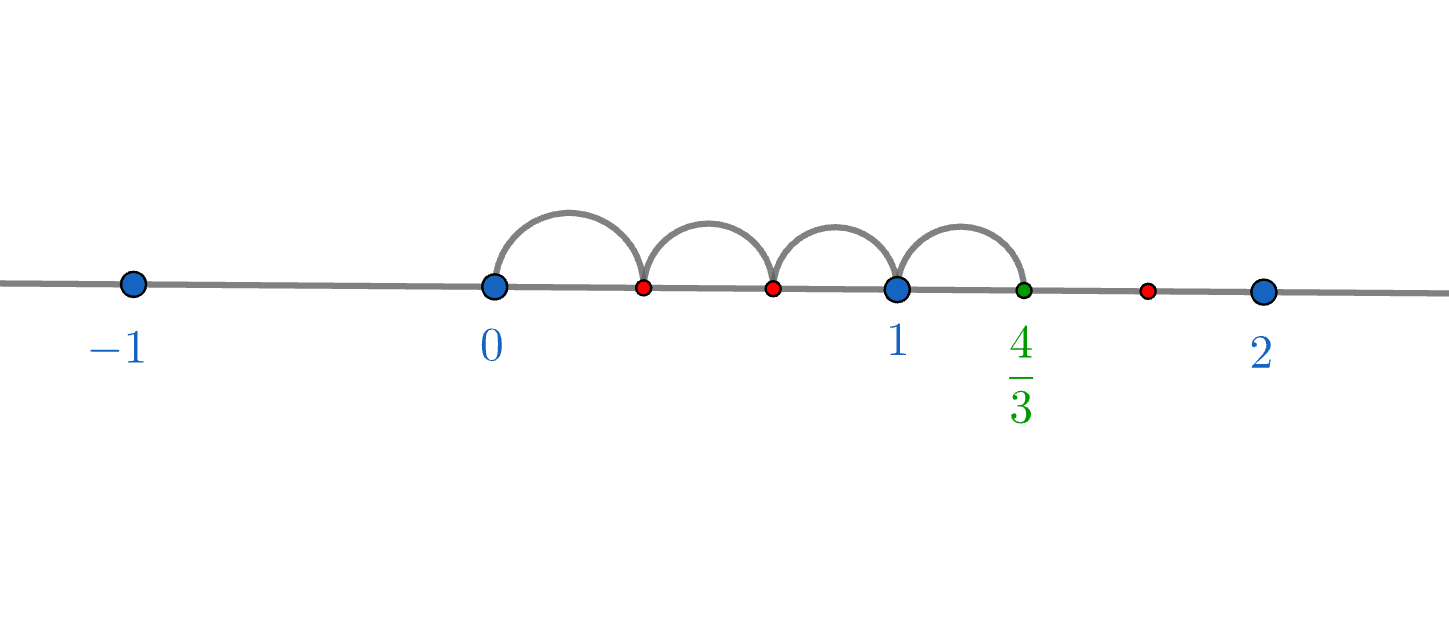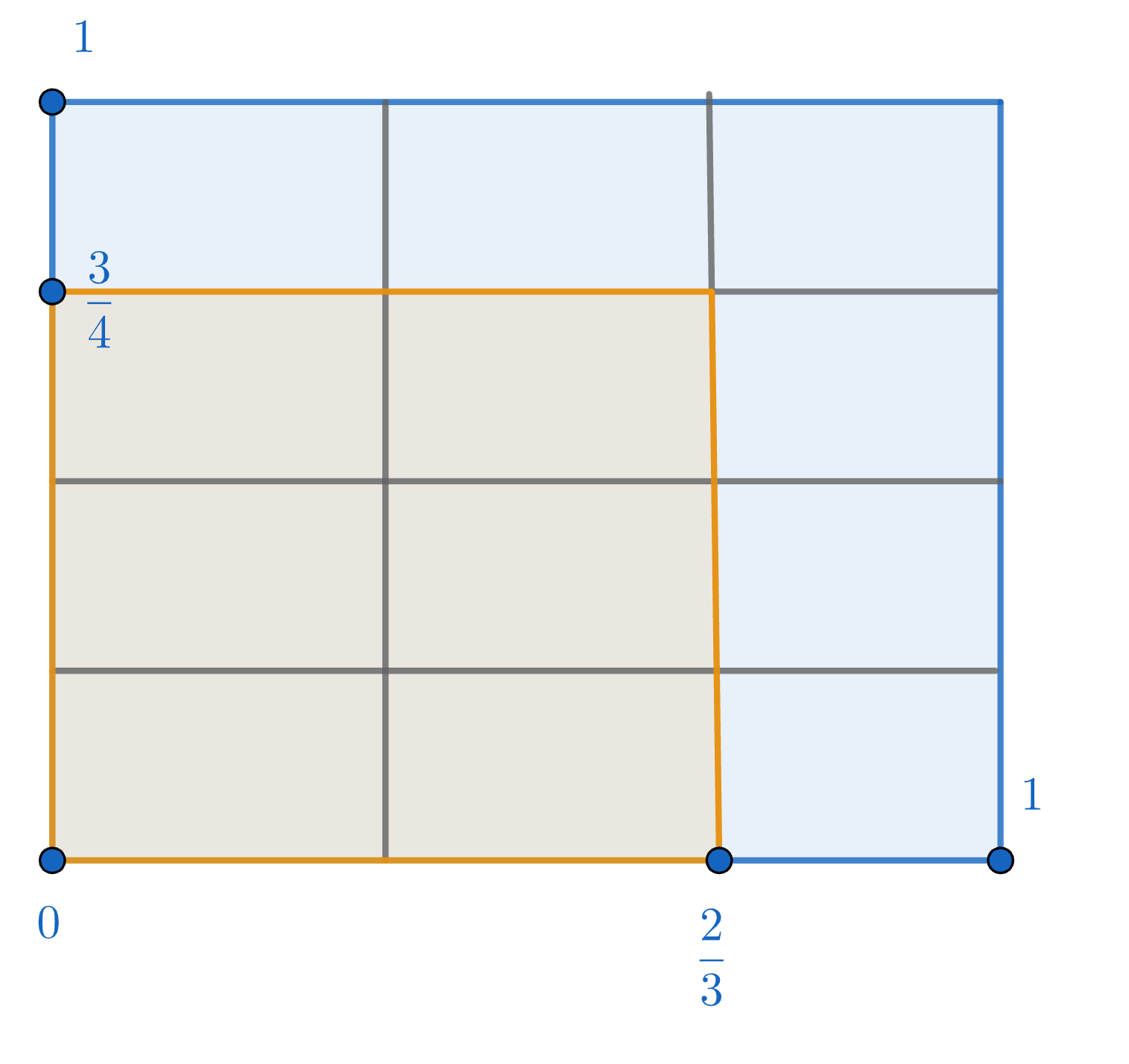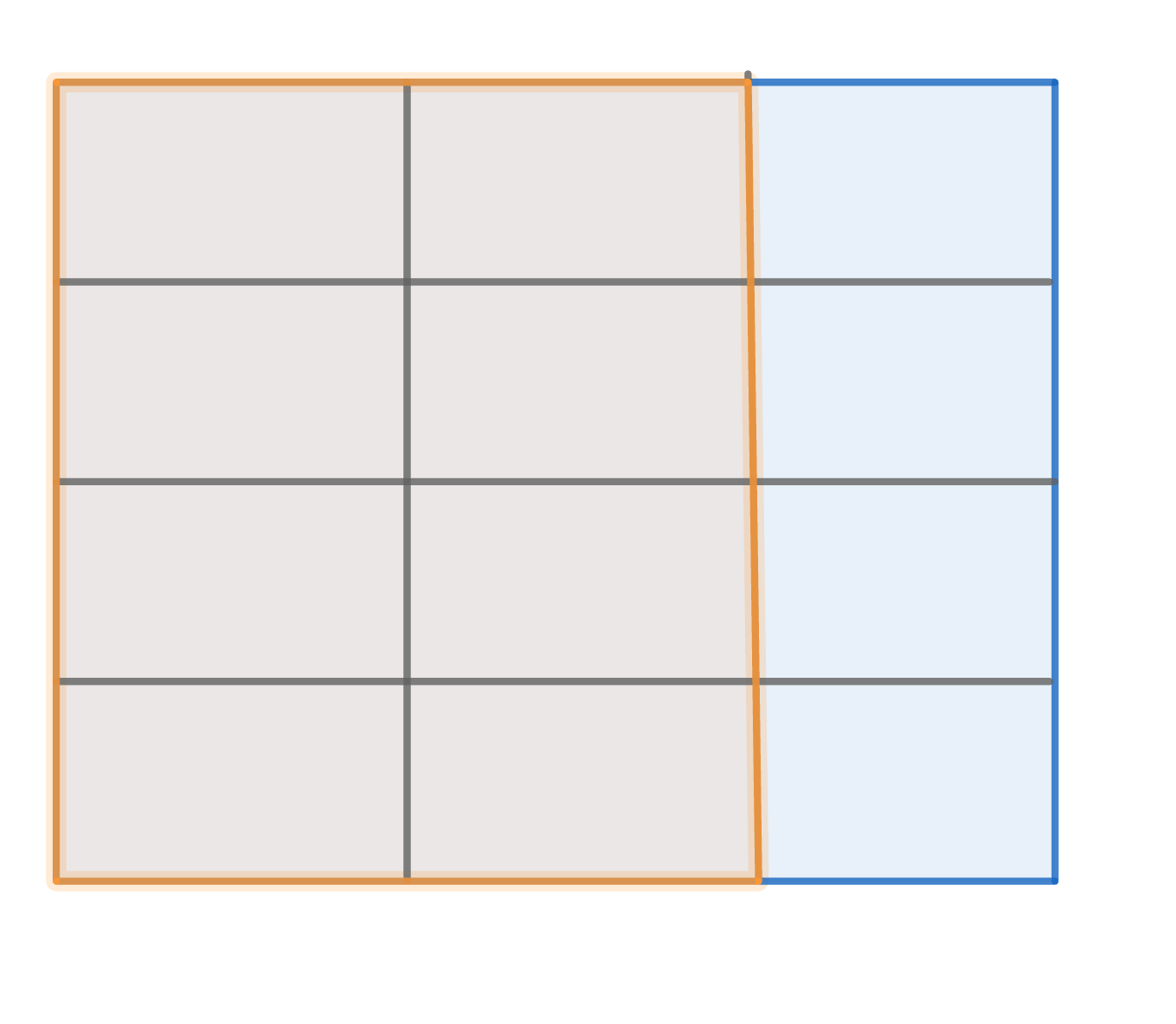1.1.2: Fractions
- Page ID
- 136543
By the end of this section, you will be able to:
- Understand arithmetic of fractions
- Understand the meaning of fractions
Before we get started, take this readiness quiz.
1. Evaluate \(2\cdot (-2).\)
2. Evaluate \(5-(-3).\)
3. Evaluate \((-6)\div 2.\)
In our previous section we identified integers: \(0,\pm 1,\pm 2,\pm 3, \ldots .\) To this set, now we will add all ratios of integers with non-zero denominators, like \(\dfrac{2}{7}, \dfrac{-11}{17} \ldots\) We call this the set of rational numbers. Any rational number looks like \(\dfrac{p}{q}\) where \(p\) and \(q\) are integers and \(q\) is not \(0 .\). We have considered the division of integers in the previous section. We relate fractions to division in this way:
\[\dfrac{p}{q}=p\div q.\nonumber\]
We understand the meaning of this when \(p\div q\) is an integer. When it is not, we can still find the number on the numberline (at least in theory). We start with an example: \(4/3\). The denominator is the number of equal pieces we divide up 1 into. And the numerator is the number of pieces. So, in this case we divide up 1 unit into 3 pieces (so we have 3 equal length pieces for each unit on the number line) and we count 4 of them.

If a pizza is your unit, then you can think of dividing pizzas each up into 3 equal pieces and then taking 4 pieces. Then you would have \(\dfrac43\) pizzas.
Just as we are able to perform arithmetic operations with integers we can also perform arithmetic operations with rational numbers (fractions). The two types of fractions we will encounter are called proper and improper:
- Proper fractions have value less than \(1,\) for example \(\dfrac{2}{5}\) and \(\dfrac{1}{8} .\) Observe that for these fractions the numerator is less than the denominator.
- Improper fractions have value greater than or equal to \(1,\) for example \(\dfrac{7}{6}\) and \(\dfrac{3}{2} .\) For these fractions the numerator is greater than the denominator.
Each fractional value can have many different, equivalent forms, for example \(1=\dfrac{2}{2}=\dfrac{-5}{-5}=\cdots\) In order to determine whether two fractions are equivalent we can use the fundamental principle of fractions.
Equivalent fractions
For \{b,c\neq 0\),
\[\dfrac{a\cdot c}{b\cdot c}=\dfrac{a}{b}.\nonumber\]
In this case, we say \(\dfrac{a\cdot c}{b\cdot c}\) and \(\dfrac{a}{b}\) are equivalent.
Reducing a fraction
For positive integers \(a\) and \(b\), we say that \(\dfrac{a}{b}\) is reduced if there is no equivalent fraction with smaller positive numerator/denominator. Reducing a fraction means to find the reduced equivalent fraction.
If \(a\) or \(b\) is negative, then we limit the sign to the numerator.
Since
\[\dfrac{2}{3}=\dfrac{2 \cdot 4}{3 \cdot 4}=\dfrac{8}{12},\nonumber\]
\(\dfrac{2}{3}\) and \(\dfrac{8}{12}\) are equivalent. In addition, \(\dfrac{2}{3}\) is reduced.
You should check these on your numberline so you see why this is the case. Check also with the idea of cutting up pizzas.
That is, as long as you multiply both numerator and denominator by the same number, the fraction value does not change, and you obtain equivalent fractions.
Example
Write a fraction that is equivalent to \(\dfrac{3}{5}\).
Solution
Begin with our original fraction \(\dfrac{3}{5}\) and apply the fundamental principle of fractions to get
\[\dfrac{3}{5}=\dfrac{3 \cdot 2}{5 \cdot 2}=\dfrac{6}{10}.\nonumber\]
Example
Simplify the fraction \(\dfrac{15}{35}\).
Solution
Begin with our original fraction and apply the fundamental principle of fractions in reverse to get
\[\dfrac{15}{35}=\dfrac{3 \cdot 5}{7 \cdot 5}=\dfrac{3}{7}.\nonumber\]
a. Is \(\dfrac{4}{10}\) equal to \(\dfrac{8}{20}\)? Explain.
b. Simplify \(\dfrac{180}{140}\).
- Answer
-
a. Yes.
b. \(\dfrac{9}{7}\)
Multiplying Fractions
To understand multiplication of fractions, we can reconsider ways to understand multiplication of the numbers \(3\) and \(4\).
\(3\cdot 4=4+4+4\) and it is also the number of squares in the following picture:
.png?revision=1&size=bestfit&width=304&height=204)
We consider the same picture when we think of multiplying fractions. For an example, let's multiply \(\dfrac23\cdot \dfrac34\). We make a square and divide up the units on horizontal side into 3 pieces and the units on the vertical side into 4 pieces. We then highlight the appropriate area.
.png?revision=1&size=bestfit&width=345&height=326)
There are a total of 12 pieces in the unit \(1\times 1\) square and there are \(6\) of those pieces highlighted. So the product is \(\dfrac{6}{12}=\dfrac12\).
So,
\[\dfrac23\cdot \dfrac34=\dfrac{6}{12}.\nonumber\]
We see that the denominator comes from the product of the denominators and the numerator comes from the product of the numerators.
We multiply numerators together and denominators together:
\[\dfrac{a}{b} \cdot \dfrac{c}{d}=\dfrac{a \cdot c}{b \cdot d}\nonumber\]
Multiply and reduce \(\dfrac{14}{3}\cdot \dfrac{9}{7}\).
Solution
The product of these two fractions is done as follows:
\[\dfrac{14 \cdot 9}{3 \cdot 7}=\dfrac{2 \cdot 7 \cdot 3 \cdot 3}{3 \cdot 7}=\dfrac{6}{1}=6\nonumber\]
Multiply and reduce:
a. \(\dfrac{5}{14}\cdot\dfrac{7}{2}\)
b. \(\dfrac{20}{21}\cdot\dfrac{14}{15}\)
- Answer
-
a. \(\dfrac{5}{4}\)
b. \(\dfrac{8}{9}\)
Dividing Fractions
To divide fractions we recognize the relationship between fractions and division. Namely, \(\dfrac{a}{b}=a\div b\). For example, \(\dfrac{5}{2}=5\div 2\).
So,
\[\dfrac{a}{b}\div\dfrac{c}{d}=\dfrac{\dfrac{a}{b}}{\dfrac{c}{d}}\nonumber\]
and we can multiply the numerator and denominator by \(\dfrac{d}{c}\) to arrive at an equivalent fraction:
\[\dfrac{a}{b}\div\dfrac{c}{d}=\dfrac{\dfrac{a}{b}\cdot\dfrac{d}{c}}{\dfrac{c}{d}\cdot\dfrac{d}{c}}=\dfrac{a}{b}\cdot\dfrac{d}{c}!\nonumber\]
The Reciprocal of a Fraction
The reciprocal of a fraction \(\dfrac{p}{q}\) is the fraction formed by switching the numerator and denominator, namely \(\dfrac{q}{p}\).
Find the reciprocal of:
a. \(\dfrac{3}{5}\)
b. \(\dfrac{-2}{7}\)
c. \(\dfrac{1}{8}\)
d. \(4\)
Solution
a. The reciprocal of \(\dfrac{3}{5}\) is \(\dfrac{5}{3}\).
b. The reciprocal of \(\dfrac{-2}{7}\) is \(\dfrac{7}{-2}=\dfrac{-7}{2}=-\dfrac{7}{2}\).
c. The reciprocal of \(\dfrac{1}{8}\) is \(\dfrac{8}{1}=8\).
d. The reciprocal of \(4=\dfrac{4}{1}\) is \(\dfrac{1}{4}\).
So to divide one fraction by another, we multiply the first fraction by the reciprocal of the second:
\[\dfrac{a}{b} \div \dfrac{c}{d}=\dfrac{a}{b} \cdot \dfrac{d}{c}=\dfrac{a \cdot d}{b \cdot c}\nonumber\]
Divide and reduce \(\dfrac{8}{3} \div \dfrac{4}{5}\).
Solution
The quotient of these two fractions is found as follows:
\(\dfrac{8}{3} \div \dfrac{4}{5}=\dfrac{8}{3} \cdot \dfrac{5}{4}=\dfrac{8 \cdot 5}{3 \cdot 4} =\dfrac{2 \cdot 4 \cdot 5}{3 \cdot 4}=\dfrac{10}{3}\)
Divide and reduce
a. \(\dfrac{5}{14}\div\dfrac{7}{2}\)
b. \(\dfrac{20}{21}\div\dfrac{14}{15}\)
- Answer
-
a. \(\dfrac{5}{49}\)
b. \(\dfrac{50}{49}\)
Adding and Subtracting Fractions (with same denominators)
The denominator simply indicates the size of the items we are counting. The numerator is the count. If the denominators are the same, we are counting things of the same size!
\[\dfrac{a}{b}+\dfrac{c}{b}=\dfrac{a+c}{b}\nonumber\]
We can also think of \(\dfrac{a}{b}\) as \(a\cdot \dfrac{1}{b}\) etc. For example, \(\dfrac26\) is two (sixths) and \(\dfrac56\) is five (sixths) so
\[\dfrac26+\dfrac56\text{ is two (sixths) plus five (sixths)}\nonumber\]
so, just like two apples plus five apples is seven apples, we have the result of seven (sixths) which is \(\dfrac76\). So, you can think if the denominator as indicating what object you are counting! This point of view might be helpful in working with and understanding fractions a bit more natural.
Similarly,
\[\dfrac{a}{b}-\dfrac{c}{b}=\dfrac{a-c}{b}\nonumber\]
Example
a. Add \(\dfrac{3}{5}+\dfrac{1}{5}\).
b. Subtract \(\dfrac{3}{5}-\dfrac{1}{5}\).
Solution
a. \(\dfrac{3}{5}+\dfrac{1}{5}=\dfrac{3+1}{5}=\dfrac{4}{5}\)
b. \(\dfrac{3}{5}-\dfrac{1}{5}=\dfrac{3-1}{5}=\dfrac{2}{5}\)
Simplify:
a. \(\dfrac{5}{14}+\dfrac{3}{14}\)
b. \(\dfrac{20}{21}-\dfrac{14}{21}\)
- Answer
-
a. \(\dfrac{8}{14}=\dfrac{4}{7}\)
b. \(\dfrac{6}{21}=\dfrac{2}{7}\)
Adding or Subtracting Fractions (with unlike denominators)
Adding (or subtracting) fractions with unlike denominators requires us to first find a common denominator.
To understand the issues of adding fractions with unlike denominator, consider the problem of asking how much pizza Ariane and Holly have together if Ariane has \(\dfrac34\) pizza and Holly has \(\dfrac23\). Ariane,say, has three slices of a pizza cut into four pieces and Holly has two slices of a pizza cut into 3 pieces. While they have 3 slices together, the slices are not the same size. So it is tricky to see exactly how much pizza they have. To see how to do this we will assume the pizzas are square (it is easier to slice), so that both fractions are easily understood. We divide each of their pizzas into 12 pieces (3 times 4).
.png?revision=1&size=bestfit&width=412&height=354) |
Ariane has \(\dfrac34=\dfrac{9}{12}\) slices. |
.png?revision=1&size=bestfit&width=427&height=372) |
Holly has \(\dfrac23=\dfrac{8}{12}\) slices. |
| Since the slices are the same size we can not just count slices. They have 17 slices of pizzas which each have 12 equal slices. So they have together \(\dfrac{17}{12}\) pizzas. |
One can always think of slicing pizzas this way, but sometimes we could manage with fewer slices. Consider what happens if Ariane has \(\dfrac16\) of a pizza and Holly has \(\dfrac34\). Can you do better than slicing each pizza into \(24\) slices each?
This leads us to the considering the smallest number of slices one needs to divide each pizza into in order that the amount of pizza that Ariane and Holly have can be some number of those slices.
The LCD or least common denominator is the smallest number that both denominators evenly divide. Once we rewrite each of our fractions so their denominator is the LCD, we may add or subtract fractions according to the above properties.
Finding the LCD
- Step 1: Make a list of (enough) multiples of each denominator.
- Step 2: Identify the lowest common multiple. If you can’t see one, then your lists in Step 1. need to be expanded.
To be able to add or subtract fractions, we need to go one more step: Once you’ve identified the LCD, rewrite both fractions (by multiplying both numerator and denominator by the appropriate same number) to get the LCD as denominator.
Example
Find the LCD and then add and simplify \(\dfrac{3}{12}+\dfrac{5}{8}\).
Solution
Let us first find the LCD by following our procedure.
| List the denominators. | \(8\) and \(12\) |
| Make a list of (enough) multiples. |
\(8: 8,16,24,32, \ldots\) \(12: 12,24,36,48, \ldots\) |
| Identify the LCD. | \(24\) |
|
Factor the LCD using \(8\) as one of the factors. Factor the LCD using \(12\) as one of the factors. |
\(24=8 \cdot 3\) \(24=12 \cdot 2\) |
| Rewrite each fraction using the LCD: |
\(\dfrac{3}{12}=\dfrac{3 \cdot 2}{12 \cdot 2}=\dfrac{6}{24}\nonumber\) \(\dfrac{5}{8}=\dfrac{5 \cdot 3}{8 \cdot 3}=\dfrac{15}{24}\nonumber\) |
| Now we are ready to add our fractions |
\(\quad\dfrac{3}{12}+\dfrac{5}{8}\) \(=\dfrac{6}{24}+\dfrac{15}{24}\) \(=\dfrac{21}{24}\nonumber\) |
| Simplify. |
\(=\dfrac{3 \cdot 7}{3 \cdot 8}\) \(=\dfrac{7}{8}\nonumber\) |
Example
Find the LCD and then subtract and simplify \(\dfrac{1}{9}-\dfrac{3}{5}\).
Solution
Let us first find the LCD by following our procedure.
| List the denominators. | \(9\) and \(15\) |
| Make a list of (enough) their multiples. |
\(9: 9,18,27,36,45,54,63, \ldots\) \(5: 5,10,15,20,25,30,35,40,45,50,55, \ldots\) |
| Identify the LCD. | \(45\) |
|
Factor the LCD using \(9\) as one of the factors. Factor the LCD using \(15\) as one of the factors. |
\(45=9\cdot 5\) \(45=15 \cdot 3\) |
| Rewrite each fraction using the LCD: |
\(\dfrac{1}{9}=\dfrac{1 \cdot 5}{9 \cdot 5}=\dfrac{5}{45}\nonumber\) \(\dfrac{3}{5}=\dfrac{3 \cdot 9}{5 \cdot 9}=\dfrac{27}{45}\nonumber\) |
| Now we are ready to subtract our fractions, but, first, we rewrite the subtraction as addition of the opposite: |
\(\quad \dfrac{1}{9}-\dfrac{3}{5}\) \(=\dfrac{1}{9}+\left(-\dfrac{3}{5}\right)\) \(=\dfrac{5}{45}+\left(-\dfrac{27}{45}\right)\) |
| Simplify. |
\(=\dfrac{5+(-27)}{45}\) \(=\dfrac{-22}{45}\) |
Simplify
a. \(\dfrac{5}{14}+\dfrac{3}{7}\)
b. \(\dfrac{2}{21}-\dfrac{4}{15}\)
- Answer
-
a. \(\dfrac{11}{14}\)
b. \(\dfrac{-7}{15}\)
Writing an Improper Fraction as a Mixed Number
By drawing a picture of pizzas, it is clear that, \(\dfrac43\) is the same as one whole pizza \(\dfrac33\) together with \(\dfrac13\), i.e., one entire pizza and one extra slice. We write \(\dfrac43=1\dfrac13\). The number on the right is called a mixed number and means 'one whole plus one-third.' You might think of a general procedure before continuing with our discussion.
- Divide the numerator by the denominator.
- If there is a remainder, write it over the denominator.
Example
Write \(\dfrac{42}{5}\) as a mixed number.
Solution
We begin by dividing the numerator \(42\) by the denominator \(5\) to get \(8,\) with a remainder of \(2\). Our mixed number is \(8 \dfrac{2}{5}\).
Write \(\dfrac{25}{3}\) as a mixed number.
- Answer
-
\(8\dfrac{1}{3}\)
Writing a Mixed Number as an Improper Fraction
- Multiply the whole number and the denominator then add the numerator. Use the result as your new numerator.
- The denominator remains the same
Example
Write the mixed number \(3 \dfrac{5}{6}\) as an improper fraction.
Solution
 Multiply the denominator by the whole number.
Multiply the denominator by the whole number. - Add this result to the numerator.
- Set this new numerator 23 over the denominator of 6.
We multiply the whole number 3 and the denominator 6 to get \(18 .\) Next, we add to this the numerator 5 to get \(23 .\) This is our new numerator and our improper fraction becomes \(\dfrac{23}{6}\).
Write the \(7 \dfrac34\) as an improper fraction.
- Answer
-
\(\dfrac{31}{4}\)
Addition and Subtraction of Mixed Numbers
To add (or subtract) mixed numbers, we can convert the numbers into improper fractions, then add (or subtract) the fractions as we saw in this chapter.
Example \(\PageIndex{18}\)
Subtract \(7-2 \dfrac{3}{8}\).
Solution
First we convert \(2 \dfrac{3}{8}=\dfrac{19}{8}\). Then, we rewrite the subtraction operation as addition of opposite:
\[7-\dfrac{19}{8}=7+\left(-\dfrac{19}{8}\right)=\dfrac{7}{1}+\left(-\dfrac{19}{8}\right)=\dfrac{56}{8}+\left(-\dfrac{19}{8}\right)=\dfrac{56+(-19)}{8}=\dfrac{37}{8}=4 \dfrac{5}{8}\nonumber\]
Also, we can keep mixed fractions and mixed fraction, and, add (or subtract) the integer parts together and the fraction parts together.
Example
Add \(7 \dfrac{3}{4}+3 \dfrac{1}{5}\).
Solution
Here, we add \(7+3=10\) and \(\dfrac{3}{4}+\dfrac{1}{5}=\dfrac{15}{20}+\dfrac{4}{20}=\dfrac{19}{20}\).
And, our final answer is \(10 \dfrac{19}{20}\). Note that \(\dfrac{19}{20}\) is a proper fraction, so, our work is done. But, if our answer ended up with an improper fraction, we would have had to make the conversion to write the answer in simplified form.
Simplify \(3\dfrac34-2\dfrac{3}{5}\).
- Answer
-
\(\dfrac{17}{20}\)
Multiplying and Dividing of Mixed Numbers
Be careful when multiplying mixed numbers. You must first convert them to improper fractions and use the rules for multiplying fractions to finish your problem.
Example
Multiply \(2 \dfrac{3}{5}\) and \(3 \dfrac{1}{2}\).
Solution
Begin by rewriting each mixed number as an improper fraction: \(2 \dfrac{3}{5}=\dfrac{13}{5}\) and \(3 \dfrac{1}{2}=\dfrac{7}{2}\). Now we proceed by multiplying the fractions
\[\dfrac{13}{5} \cdot \dfrac{7}{2}=\dfrac{13 \cdot 7}{5 \cdot 2}=\dfrac{91}{10}\nonumber\]
We can now write the result (if we wish) as a mixed number: \(9 \dfrac{1}{10}\).
Example
Divide \(\left(1 \dfrac{4}{5}\right) \div\left(1 \dfrac{1}{2}\right)\).
Solution
Begin by rewriting each mixed number as a improper fraction: \(1 \dfrac{4}{5}=\dfrac{9}{5}\) and \(1 \dfrac{1}{2}=\dfrac{3}{2} .\) Now we proceed by dividing the fractions
\[\dfrac{9}{5} \div \dfrac{3}{2}=\dfrac{9}{5} \cdot \dfrac{2}{3}=\dfrac{9 \cdot 2}{5 \cdot 3}=\dfrac{3 \cdot 2}{5 \cdot 1}=\dfrac{6}{5}=1 \dfrac{1}{5}\nonumber\]
Divide \(7 \dfrac12\) by \(2\dfrac23\).
- Answer
-
\(\dfrac{45}{16}\)
- Give an application of fractions.
- Explain why a common denominator is needed when adding or subtracting fractions.
- Give an example of multiplication of two fractions which are not integers.
- How might you go about converting a negative improper fraction into a mixed number? Give an example.
- Give an example of adding two fractions with unlike denominators.
- Give an example of how to divide two fractions which are not integers.
Evaluate \(\dfrac{3}{4}-1 \dfrac{5}{6}\).
Key Concepts
- Fraction
- Adding/subtracting fractions
- Multiplying/dividing fractions
- Mixed numbers
- Improper fractions


